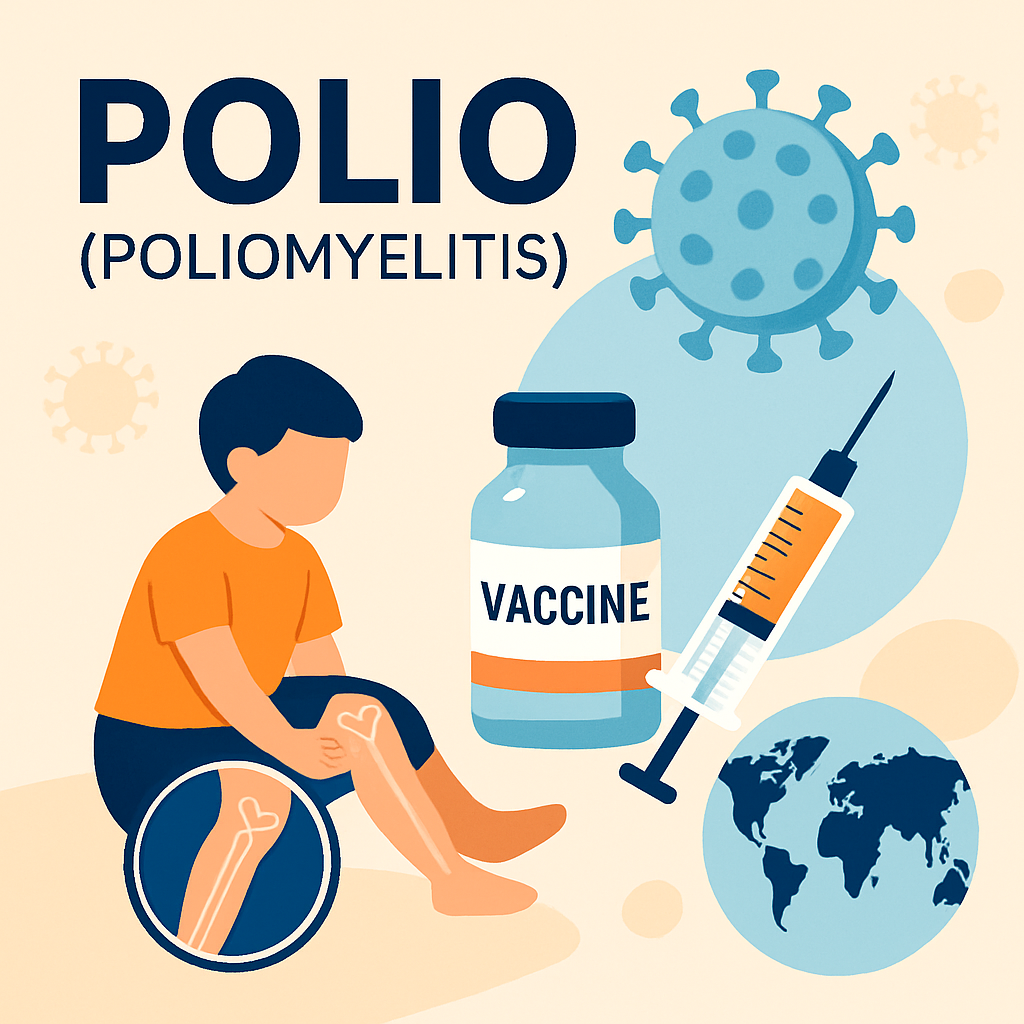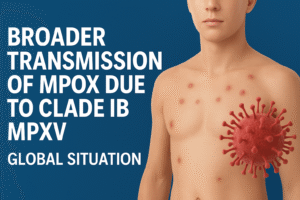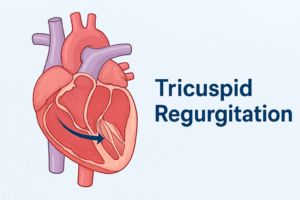Imagine a disease that once paralyzed hundreds of thousands of children every year, leaving families devastated and communities fearful. That disease is polio, medically known as poliomyelitis. Caused by the poliovirus, it is highly contagious and mainly affects children under five. In severe cases, it can result in permanent paralysis or even death.
Thanks to decades of global vaccination campaigns, the fight against polio has been one of the greatest success stories in public health. According to the World Health Organization (WHO), polio cases have declined by more than 99% since 1988. Yet, the battle isn’t fully over. The virus continues to linger in a few parts of the world, reminding us why awareness and prevention are still critical.
Understanding the Poliovirus: The Root Cause
Polio doesn’t just appear out of nowhere—it has one culprit: the poliovirus. This virus spreads primarily through:
- Contaminated water and food
- Poor hygiene practices
- Direct contact with an infected person
Once the virus enters the body, it multiplies in the intestines. In some cases, it invades the central nervous system, destroying nerve cells that control muscle movement. This is what leads to paralysis—the most feared outcome of polio.
How Polio Progresses: Stages of Infection
Polio is not a one-size-fits-all illness. It develops in stages, each with different symptoms and severity:
- Incubation (3–35 days): The virus multiplies silently without obvious signs.
- Mild Stage (Abortive Polio): Symptoms resemble the flu—fever, headache, fatigue, sore throat.
- Intermediate Stage (Non-Paralytic Polio): Stiff neck and meningitis-like symptoms emerge.
- Severe Stage (Paralytic Polio): Sudden paralysis in the legs, arms, or even respiratory muscles.
- Long-Term Effects (Post-Polio Syndrome): Decades later, survivors may face muscle weakness, joint pain, and fatigue.
Understanding these stages helps in early detection and medical intervention.
Classifications of Polio
Doctors classify polio into three main categories:
- Abortive Polio: The mildest form, often mistaken for a viral flu.
- Non-Paralytic Polio: Causes meningitis-like symptoms but doesn’t lead to paralysis.
- Paralytic Polio: The rarest but most dangerous form, resulting in irreversible paralysis.
Key Warning Signs and Symptoms
Polio doesn’t always show its full face immediately. Here are the common symptoms to look out for:
- General Symptoms: Fever, fatigue, nausea, sore throat.
- Neurological Symptoms: Muscle stiffness, neck pain, meningitis-like signs.
- Paralytic Symptoms: Sudden loss of reflexes, asymmetric paralysis, difficulty breathing.
While mild symptoms may pass unnoticed, paralytic polio can change lives forever.
How Polio Is Diagnosed
Diagnosing polio requires a mix of clinical observation and laboratory testing. Doctors may use:
- Stool and throat samples to detect the virus.
- Cerebrospinal fluid (CSF) analysis in cases with meningitis-like symptoms.
- Neurological exams to assess muscle weakness or paralysis.
Early diagnosis is crucial, not just for the patient, but also to prevent the spread of the virus.
Managing Polio Without a Cure
Here’s the hard truth: there is no cure for polio. But that doesn’t mean patients are left without help. Supportive care can significantly improve quality of life:
- Physiotherapy and rest to manage pain and strengthen muscles.
- Rehabilitation therapy to prevent deformities.
- Mechanical ventilation for patients with breathing difficulties.
- Orthopedic interventions such as braces or corrective surgery.
With timely care, many polio survivors lead fulfilling lives despite challenges.
The Power of Prevention: How to Protect Against Polio
Since polio has no cure, prevention is everything. The good news is that vaccines offer near-complete protection.
- Vaccination
- Oral Polio Vaccine (OPV): Given as drops, ideal for mass immunization drives.
- Inactivated Polio Vaccine (IPV): Injected vaccine, offering stronger individual protection.
- Sanitation & Hygiene
- Access to clean water.
- Proper waste disposal.
- Regular handwashing habits.
- Global Immunization Campaigns
Initiatives like the Global Polio Eradication Initiative (GPEI) have been game-changers, delivering vaccines to remote corners of the world and drastically reducing cases.
Nutrition and Diet for Polio Recovery
While diet cannot prevent polio, good nutrition plays a big role in recovery and long-term health:
- Protein-rich foods (eggs, beans, lean meats) help repair muscles.
- Calcium and Vitamin D (dairy, leafy greens) strengthen bones.
- Fruits and vegetables boost immunity with vitamins and antioxidants.
- Adequate hydration supports overall well-being.
Who Is Most at Risk?
Certain groups face a higher risk of contracting polio:
- Children under five (the most vulnerable group).
- Unvaccinated individuals of any age.
- Communities with poor sanitation and overcrowded housing.
- Travelers visiting regions where polio is still endemic.
Global Impact and Eradication Efforts
Polio eradication is one of the most inspiring global health missions. Consider this progress:
- 1988: 350,000 cases in 125 countries.
- Today: Fewer than 200 cases per year worldwide.
- Polio-Free Regions: The Americas, Europe, Africa, and South-East Asia.
- Still Endemic: Afghanistan and Pakistan.
However, outbreaks of vaccine-derived poliovirus in under-immunized communities show that the fight isn’t finished yet.
Stories of Hope: The Human Side of Polio
Behind every statistic lies a story. For decades, families lived in fear of polio outbreaks. Today, thanks to tireless efforts of health workers—many walking miles through remote villages—millions of children are safe. These stories reflect human resilience, global cooperation, and a shared belief that polio can and must be eradicated.
Frequently Asked Questions (FAQs)
1. Is polio curable?
No. Vaccination is the only way to protect against polio.
2. Can adults get polio?
Yes. If unvaccinated, adults remain at risk.
3. How does polio spread?
Through contaminated food, water, or close contact with infected individuals.
4. What is the difference between OPV and IPV?
- OPV: Oral drops, best for large-scale immunization.
- IPV: Injection, provides stronger personal immunity.
5. Can polio return to polio-free countries?
Yes, if vaccination rates drop, outbreaks can re-emerge.
6. Who is most vulnerable?
Children under five and unvaccinated communities.
Conclusion
Polio may no longer dominate headlines, but it hasn’t disappeared. Vaccination remains the strongest shield we have, and global eradication is within reach if efforts continue. Every dose given to a child today brings us closer to a polio-free world tomorrow.
The story of polio is not just about a virus—it’s about human determination, scientific progress, and hope. And together, we can finish what the world started decades ago: ending polio once and for all.
Read out article on – https://newsarmour.com/hepatitis-causes-symptoms-prevention-treatment/
Sources : –
World Health Organization (WHO) – Poliomyelitis Fact Sheet
https://www.who.int/news-room/fact-sheets/detail/poliomyelitis
Global Polio Eradication Initiative (GPEI) – Polio Today
https://polioeradication.org/polio-today/
Centers for Disease Control and Prevention (CDC) – Polio Causes and Prevention
https://www.cdc.gov/polio/what-is-polio/index.html
UNICEF – Global Fight Against Polio
https://www.unicef.org/immunization/polio
National Institute of Neurological Disorders and Stroke (NINDS) – Post-Polio Syndrome
https://www.ninds.nih.gov/health-information/disorders/post-polio-syndrome







